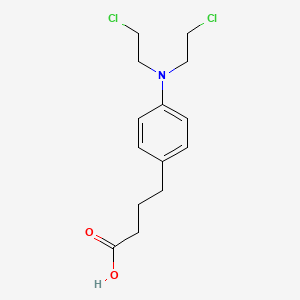Chronic lymphocytic leukaemia
Adult: Initially, 0.15 mg/kg daily until the total leucocyte count falls to 10,000 cells/mm3. Daily dose should not exceed 0.1 mg/kg if bone marrow presents lymphocytic infiltration or is hypoplastic. Maintenance: 0.03-0.1 mg/kg daily (once remission is established). Alternatively, initiate at 0.4 mg/kg as a single dose, then increase by 0.1 mg/kg at each 2- or 4-week dose interval until lymphocytosis is controlled or toxicity occurs. Dosing recommendations may vary among countries and individual products (refer to detailed product or local treatment guidelines).
Elderly: Initiate at the lower end of the dosing range.
Elderly: Initiate at the lower end of the dosing range.
Oral
Non-Hodgkin's lymphoma
Adult: As a single agent: Initially, 0.1-0.2 mg/kg daily for 4-8 weeks. Daily dose should not exceed 0.1 mg/kg if bone marrow presents lymphocytic infiltration or is hypoplastic. Maintenance: 0.03-0.1 mg/kg daily (once remission is established). Dosing recommendations may vary among countries and individual products (refer to detailed product or local treatment guidelines).
Elderly: Initiate at the lower end of the dosing range.
Elderly: Initiate at the lower end of the dosing range.
Oral
Hodgkin's disease
Adult: As a single agent in the palliative treatment of advanced disease: 0.2 mg/kg daily for 4-8 weeks. Daily dose should not exceed 0.1 mg/kg if bone marrow presents lymphocytic infiltration or is hypoplastic. Maintenance: 0.03-0.1 mg/kg daily (once remission is established). Dosing recommendations may vary among countries and individual products (refer to detailed product or local treatment guidelines).
Elderly: Initiate at the lower end of the dosing range.
Elderly: Initiate at the lower end of the dosing range.
Oral
Waldenstrom's macroglobulinaemia
Adult: Initially, 6-12 mg daily until leucopenia occurs. Maintenance: 2-8 mg daily indefinitely. Treatment and dosing recommendations may vary among countries and individual products (refer to detailed product or local treatment guidelines).
Elderly: Initiate at the lower end of the dosing range.
Elderly: Initiate at the lower end of the dosing range.




 Sign Out
Sign Out




